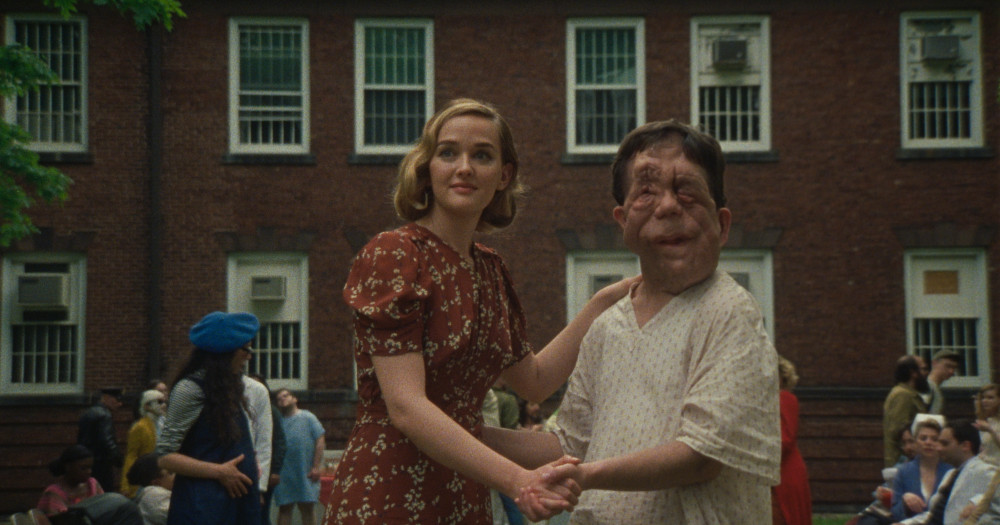Blog #5/19 – The Day of Disobedience
by Roger Koza
Only a cheeky film critic—and, here, programmers, too—could ever entertain the idea of bringing together Aaron Schimberg and Albert Serra in one journey to argue about the aesthetic merits of vanity. Screening a double program with, first, the extraordinary film Chained for Life and, then, the cinematic meteorite entitled Roi Soleil shows a rigorous filmic knowledge as well as a lot of courage. In paper, the two films belong to incommensurable universes. What does an indie comedy about the shooting of a B-film has to do with an example of the most extreme avant-garde cinema? How can a film which won FidMarseille coexist with another one that was screened in the Fantasia Film Festival?
Fréderic Jaeger and his colleagues, Vivien Buchhorn and Dennis Vetter—the main responsible parties for the Woche der Kritik—honored the most generous film-lovers’ tradition; the one able to bring together Jerry Lewis and Jean-Marie Straub; or the one that refuses to recognize those categories which pretend to confer artistic respectability to cinema for the sake of its expressive freedom. They were capable of recognizing Serra and Schimberg as two free filmmakers who believe passionately in what they do.

Chained for Life is nothing but a humorous deconstruction of the notion of beauty in its association to cinema and, specifically, to actors as its guardians. Schimberg’s film opens with a quotation where Pauline Kael talks about the legitimacy of the beauty of the actors and, from then on, what comes into play is the complete destitution of authority in that quotation celebrating inconsequentiality. “Fuck Kael!” was the last thing heard in the movie theater.
Chained for Life begins with the story of a film’s shooting where some sort of reincarnation of the “Elephant Man” (that’s how he was defined by Horst Bredekamp, one of the participants in the discussion after the screening) stars for the first time in his life in a film with a renowned European actress in the main role. Actually, Chained for Life mixes scenes from that under-construction film with moments of its preparation and various periods of rest during its filming, together with a few dreams and a third alternative film which the extras (just as “ontologically” anomalous, as if they all were the grandsons of the Freaks’ cast) together with the deformed protagonist begin to shoot during their periods of nightly rest.

The mise en abyme is a programmatic one, as well as the magnificent chromatic conception and the use of wide shots and purposeful closeups of the characters’ faces, which are justified because the direct confrontation with the faces of those “others” in cinema is indispensable if we are to question the codification of beauty that films usually assert through their stars. The same thing happens with the “narrative cross-dissolves,” or the forms in which each of the stories are associated—the changing diegesis never strays in its effort to erode the dominant concept of beauty.
In Roi Soleil, a one-hour film with less than 35 shots linked together with remarkable rhythmic precision, the great Lluis Serrat substitutes Jean-Pierre Léaud as the agonizing King Louis XIV adhering to the actual death of Louis XIV. The film takes its material from a 4-hour installation in Lisbon; but, as Serra himself said, somehow the camera manages to single out the experience and goes beyond the will of the filmmaker. Serra was passionate in his insistence on that mechanical procedure which is somewhat primitive but also rekindles an indeterminate area right in the chore of each scene; this is what it means a “cinema of presence” in opposition to a “cinema of action.”

During the debate after the screenings, Bredekamp underlined Louis XIV’s lonely nature, both in the preceding film as in this one, and linked the isolation of the king who is being watched by everyone in the intimacy of his death with the current position of individuals, who are always being watched and want to be so. In that respect, the final 15 minutes in Roi Soleil are materially devastating because the dead body´s loneliness in front of the viewers of the installation achieves an inhuman nature due to the position chosen in its register.
It was a superb journey. Professor Bredekamp was lavish in his conceptual precision; Serra and Schimberg’s contributions were revealing; and the presence of famous actress Ingrid Caven in the discussion table provided a concrete testimony of the implications of disobedience in the filmic art. Let’s remember that all this revolved around the examination of the place of vanity in cinema. However, and mysteriously so, more was spoken about fragility, a disregarded concept (perhaps the secret inversion of vanity), a concept that has nothing to do in a culture dominated by the mighty and the strong.

